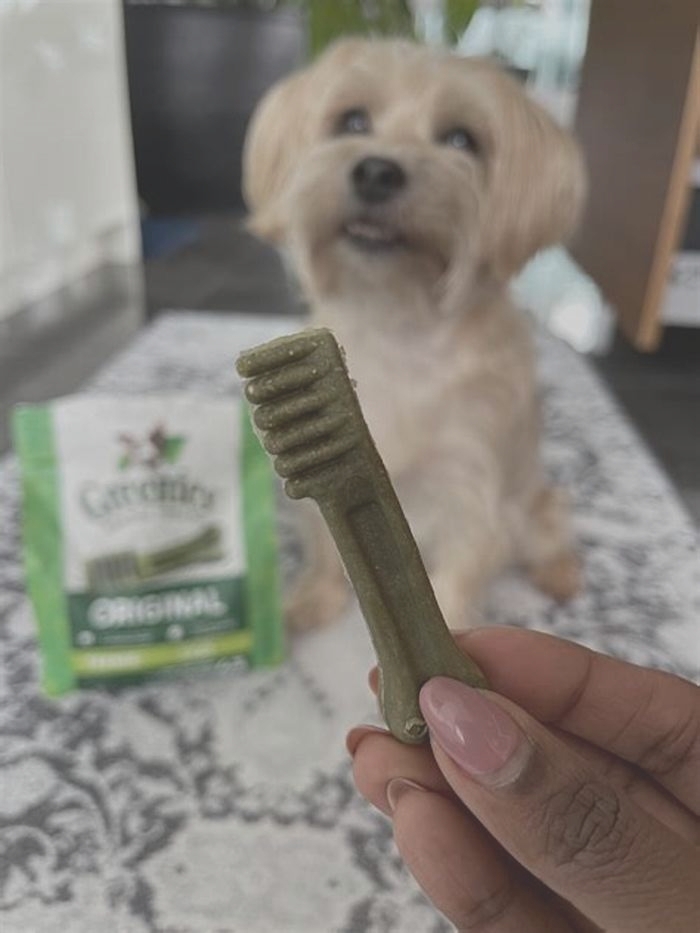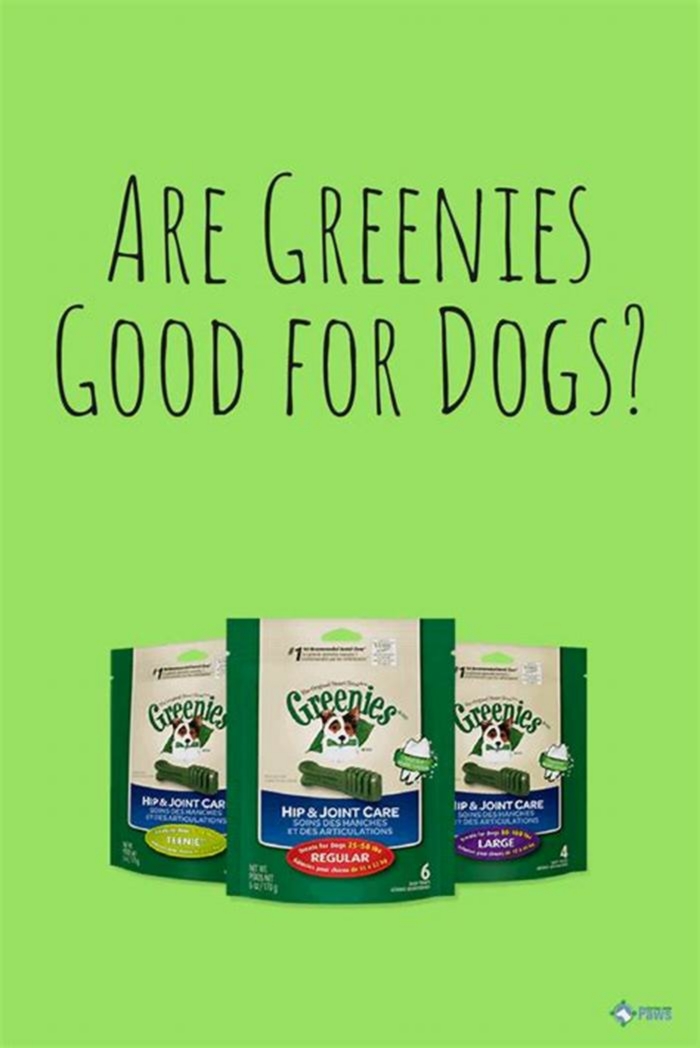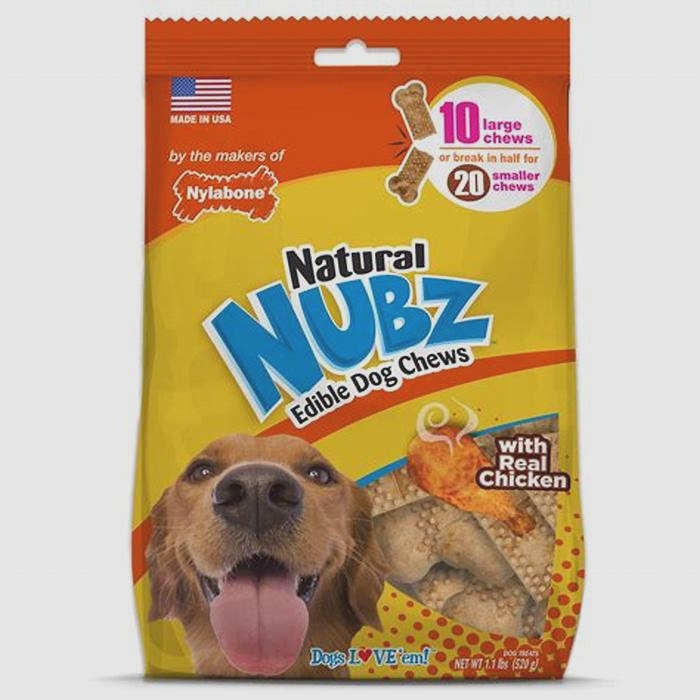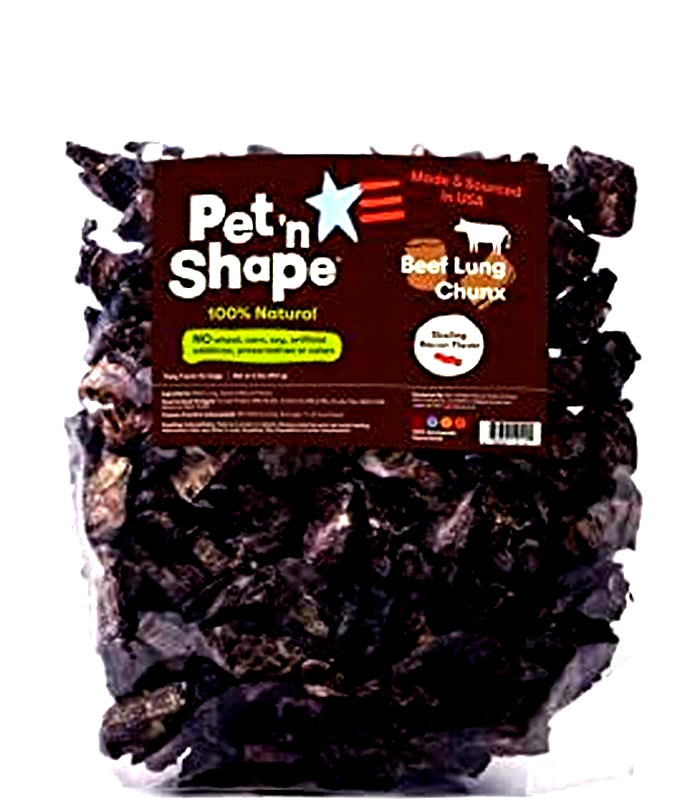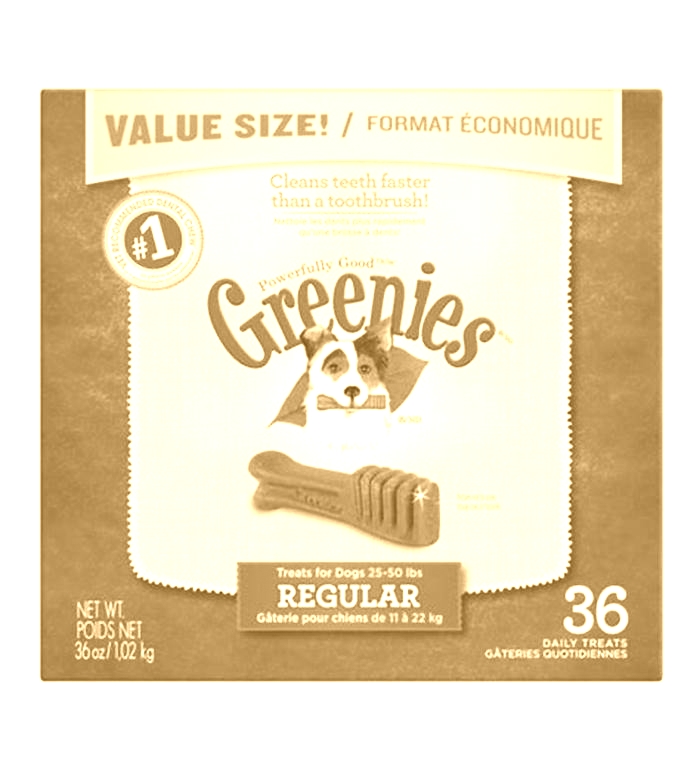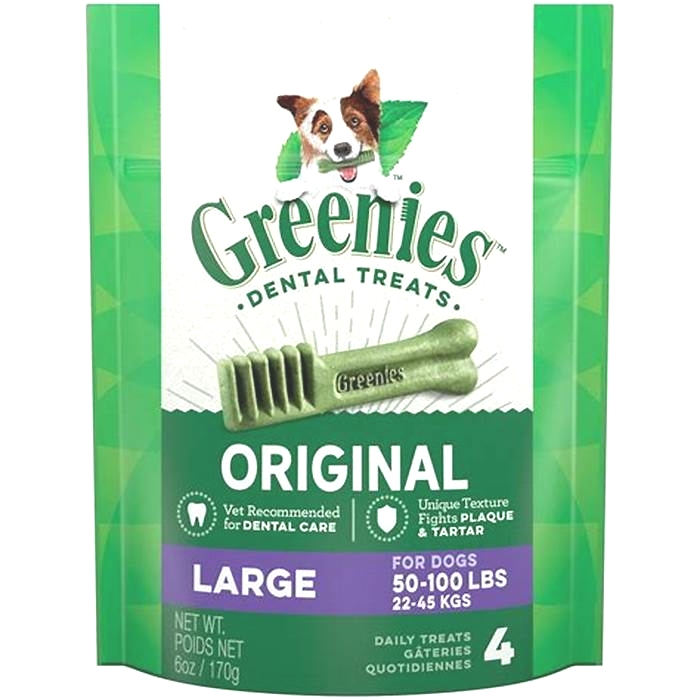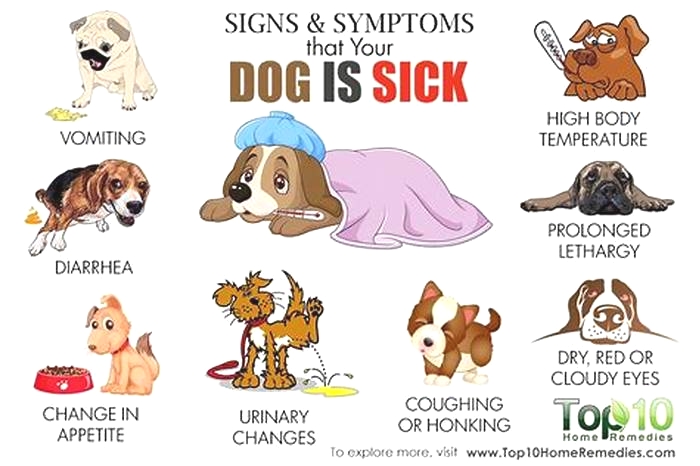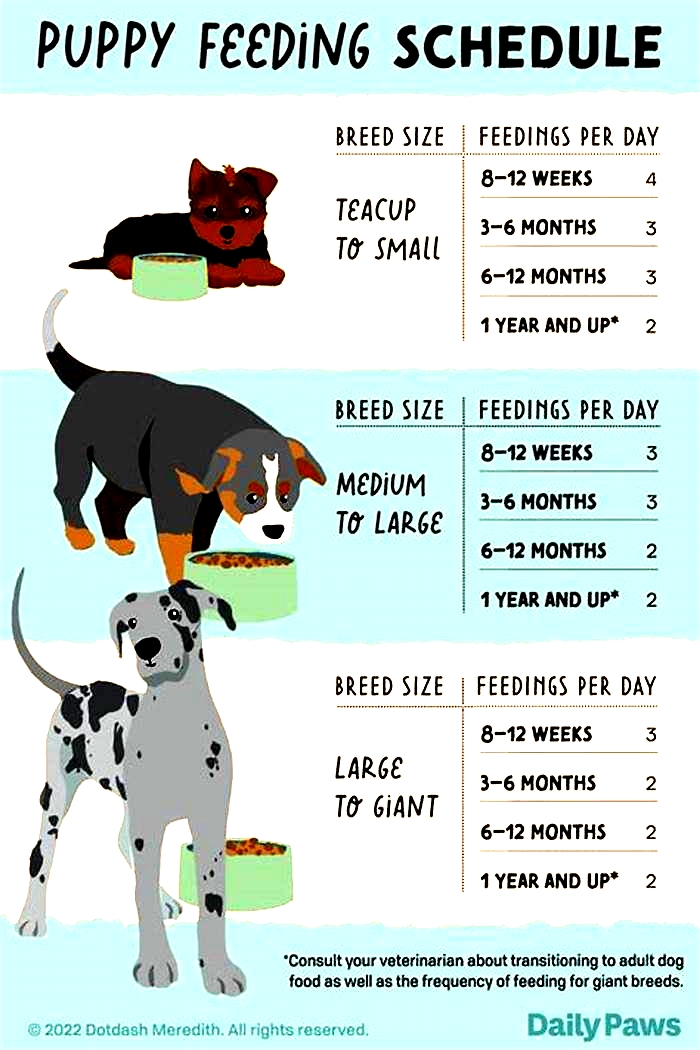Do Greenies cause blockage in dogs
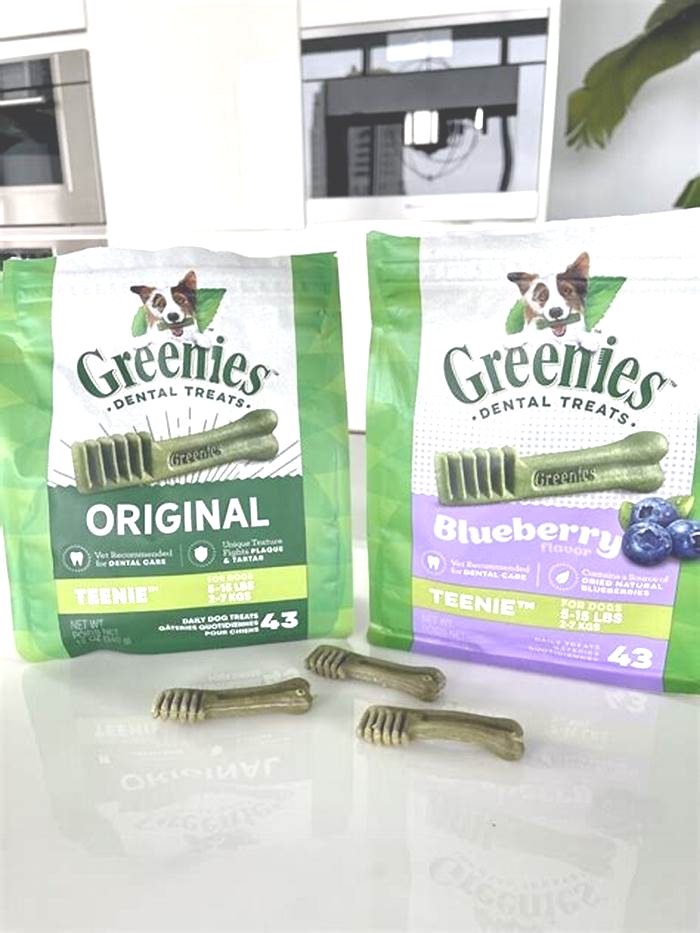
Greenies Dog Treats Are Actually BAD For Your Dog
This post may contain affiliate links. If you click and buy something that I recommend, I might receive a small commission.

If you are a dog owner, then you are probably familiar with Greenies for dogs, the green toothbrush-shaped dental chews found in most big-box pet retailers like Petsmart and Petco.
Greenies for dogs is one of the most popular dental treat brands.
But, should they be so popular? Is their product really that great, or is it a result of clever marketing and packaging?
What if I told you giving your dog Greenies dog treats for dental care, is actually doing more harm than good?
Greenies & Dog Dental Care
The main reason why pet parents purchase Greenies dental chews is for the dental care benefits that Greenies boasts their product provides.
On their website, Greenies.com states:
Dental treats or dental chews work with mechanical action similar to how your toothbrush works, where it will scrape the surface of the tooth and help brush away plaque and tartar that can accumulate that can lead to more serious problems.
Greenies.com
This entire statement focuses on the benefits of chewing, but fails to address the most important topic What is your dog actually chewing on.
Greenies also brag about their seal of approval from The Veterinary Oral Health Council.
However, on the first page of VOHCs website, they state:
When VOHC authorizes the use of its Registered Seal, VOHC makes no certification, representation or warranty as to the safety and certifies only that, upon application for the right to use the Registered Seal, the product met VOHCs Standards for effectiveness in retarding plaque and tartar when used as directed.
VOHC Website
There is no denying that chewing or gnawing has proven to be an effective method for keeping a dogs teeth clean, gums healthy, and freshen breath.
However, it is important to understand that dogs are consuming what they are chewing on.
So yes, chewing on say, a shoe, may be beneficial for your dogs teeth and gum health, but that doesnt mean it is healthy for your dog to be consuming shoes.
Moreover, consuming some ingredients, sugars, and carbohydrates specifically, can actually promote plaque and tartar build-up.
So, in the short term, dental chews like Greenies dog treats might effectively remove plaque and tartar from your pups teeth.
But, in the long term, they are actually contributing to the overall plaque and tartar problem.
The Ingredient Label Of Greenies Dog Treats
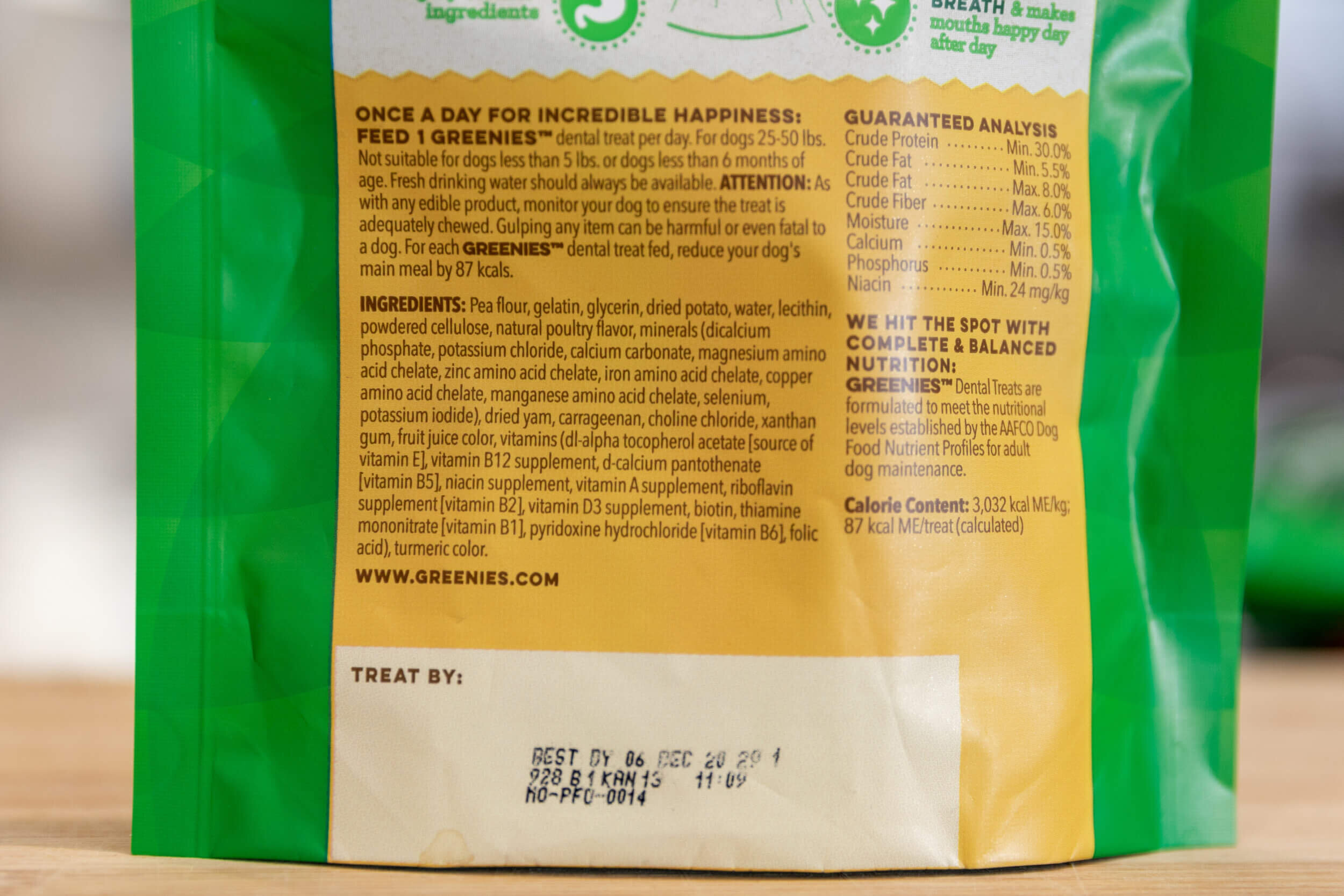
Pea Flour
Consumers havebecome savvier and more informed about the ingredients they are giving their pets.
Many are refusing to buy products with ingredients such as meals, by-products, and cheap fillers.
To replace these lower-quality products, things like grain-free pet products have grown in popularity.
Because of this, pet product manufacturers have been looking for ways to replace those cheap fillers and grains that consumers have identified as undesirable with something more appealing.
So, what did those manufacturers do?
They took out the cheap grain fillers (previously wheat flour and wheat gluten in the original Greenies) and replaced them with pea flour and pea protein (another cheap filler).
The marketing team slapped a grain-free label on their new product and started pushing it out to retailers nationwide.
Dont believe me?
Check out this Original Greenies ingredient label (below) and compare it with the Grain-Free one (above).
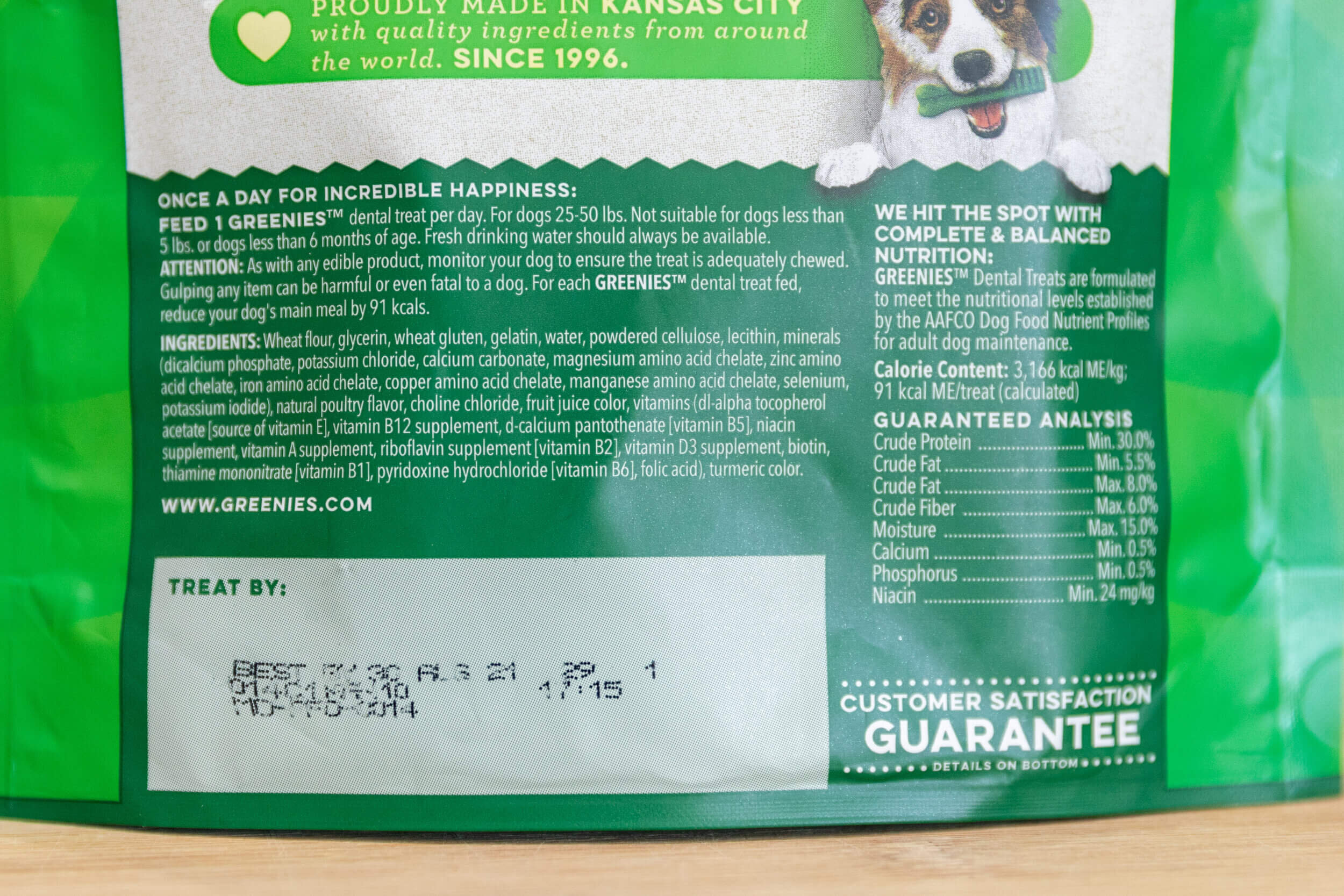
Why is pea flour/pea protein bad for my dog?
It is important to understand that pea protein is avegetable protein, not an animal protein.
Because of this, pea protein is harder to digest for dogs.
Your dogs body wont be able to break down and absorb all of the protein they are consuming.
So, most of the protein they are consuming is wasted.
Pea flour isnt just a bad source of protein, it is also full of carbohydrates.
When digested, the carbohydrates found in pea flour are broken down into sugars in the mouth which fuel plaque and tartar build-up on your dogs teeth.
Pea flour is nothing more than a cheap filler disguised as a protein that actually makes your dogs dental health worse.
So, why is it found in your dogs chew?
Manufacturers add pea protein to artificiallyinflate the protein percentages in grain-free pet products.
The protein found on the label is not the actual amount of protein that your dog is able to digest and use.
The remaining undigested protein serves no purpose for your dog, no nutritional value, and will eventually leave your dogs body as waste.
You wont find pea fiber in high quality commercially available pet foods, nor will you find it in healthy recipes for homemade pet meals. Where you will find it is in very affordable, highly processed, low-quality pet food, saidDr. Karen Becker, DVM
Once again, pet product manufacturers have found a new way to trick pet parents into thinking their products are better and healthier than they actually are.
Gelatin
Gelatin isnt a horrible ingredient for your dog to consume. Actually, it can be quite beneficial (assuming its sourced safely and naturally).
Gelatin comes from collagen which is rich in animal protein and amino acids.
Greenies manufacturers add it as a gelling agent which causes their product to be gummy and chewy.
You can provide your dog with a natural source of gelatin by feeding bone broth (which you can make at home).
Glycerin
If your dog has ever had an upset stomach after consuming Greenies, then glycerin is likely to blame.
Glycerin is a form ofsugar alcoholthat dogs (and humans) cannot fully absorb. It offers the same nutritional benefits as sugar, with even more calories.
Glycerin attracts water like a sponge. When consumed, glycerins moisture-attracting properties pull water from the body into the colon, acting as a laxative and stimulating bowel movements (i.e. gas and diarrhea).
If diarrhea wasnt bad enough, the sugar in glycerin is also very bad for your dogs dental health. The high carbohydrate content directly fuels plaque and tartar build-up, further worsening the overall health of your dogs teeth and gums.
So, why is it found in your dogs chew?
Because glycerin has that moisture-attracting property we talked about earlier, adding glycerin to foods helps them stay moist.
Generally speaking, glycerin is widely used in food manufacturing as a preservative.
Although glycerin helps the manufacturer control the moisture content in their product, it offers no nutritional benefit to your pet.
It is just a moisture-absorbing sugar.
Dried Potato
Dried potato is another starchy filler that is very similar to pea flour. It offers little nutritional benefit for your dog.
Just like glycerin and pea flour, the carbohydrates found in potatoes also break down into sugars that fuel plaque and tartar build-up.
This actually works AGAINST your dogs teeth and gum health.
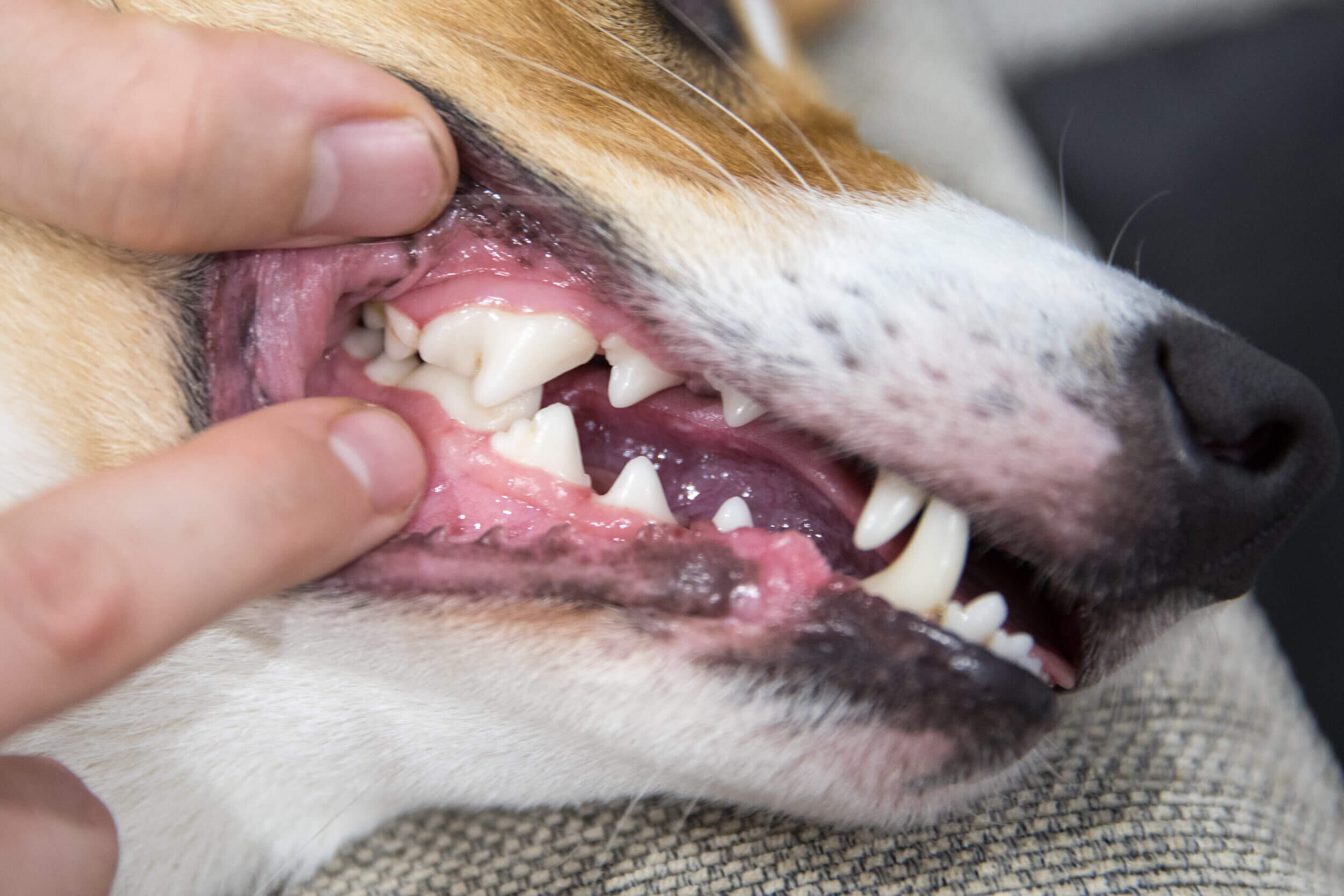
Alternatives To Greenies Dog Treats
Unfortunately, Greenies success is likely the result of well-designed packaging and clever marketing. Not because their product is of high quality.
Now, just because Greenies for dogs are off the list, that doesnt mean you are out of options.
There are lots of other safe and healthy for you to give your dog.
Here are 5 ways you can control, reduce, or eliminate plaque and tartar in your dogs mouth:
1.Healthy Diet
The foundation of a healthy mouth starts with a healthy diet.
It is important to avoid foods with highly processed ingredients such as corn and potatoes.
Bacteria are known to thrive on carbohydrates (namely sugar and starches).
So, when your dogs food gets stuck in their teeth, it provides a place for plaque to feast and tartar to develop.
By feeding your dog a balanced, high-quality diet, you can drastically reduce the risk of canine periodontitis developing.
2.Chewing
When you are looking for products to give your dog to promote dental care, I recommend looking for single ingredient products.
I typically recommend products like bully sticks or beef tendon.
These products offer the same benefit as mechanical chewing: clean teeth freshen breathe, and healthy gums.
Without contibuting to the problem with filler ingredients which feeds dental disease.
Along with providing single-ingredient chews, It is important that you continue to regularly brush your dogs teeth to prevent canine periodontitis.
Avoid These Chews
- Greenies Dog Treats
- Flavored Dental Chews (Like Dentastix)
- Antlers, Horns, Hooves
- Himalayan Yak Chew
- Nylabone/Benebone
- Rawhides
Give These Chews Instead
- Beef Pizzle (Bullysticks)
- Pig. Lamb, or Cow ears
- Duck or Chicken Feet
- Beef Tendon
- Beef Trachea
- Turkey Necks
Always supervise your dog when they are chewing. All chews are choking hazards.
These alternative chews can typically be found at your local ethnic food store or butcher shop.
The key to success is to find a single-ingredient chew that is not heavily processed and has little to no carbohydrates or sugars.
There are also companies like Farm Hounds that deliver natural single-ingredient dog treats and chews straight to your door.
You can make individual purchases, or they offer a convenient monthly subscription box service.
3.Meal Additives
A great way to combat plaque is to stop it at the source by using a meal additive such asPlaqueoff(or kelp/seaweed).
Plaqueoff is made from 100% natural seaweed which has been shown to significantly reduce plaque and tartar build-up in dogs.
It inhibits the plaque from sticking to surfaces in the mouth as well as softens the already existing tartar.
Solutions like additives dont work overnight but improvements should be seen anywhere from 3 to 8 weeks.
4.Brushing
We all know that the best way to clean teeth is to brush them. After all, isnt that how we clean our own teeth? Ideally, a dogs teeth should be brushed twice a day.
Homemade Doggy Toothpaste
Baking Soda (2 tbsp)
Coconut Oil (2 tbsp)
Peppermint Oil (1 drop)*optional
5.Dental Cleanings
For many dogs, periodontal disease has already set in under the gum line and no amount of brushing, chewing, or meal additives will help.
At this point, it is best to take your dog in for an oral exam, x-rays, and cleaning with a licensed veterinarian.
There are always risks associated with anesthesia, but the risks of canine periodontitis far overshadow the risks involved with anesthesia.
If a vet recommends a dental cleaning for your pet, it is always in their best interest to get one done.
Final Thoughts
There is no room for excuses!
It is time to throw that box of Greenies away and make the switch to single-ingredient chews that are actually going to improve your dogs dental health long term.
Many pet product manufacturers have caught on to the fact that their consumers are becoming more educated and aware of the products they are buying.
In turn, manufacturers have learned how to present their products as seemingly healthy by using terms like, high-protein, grain-free, and all-natural.
For things like dental chews, you should always strive to stay away from products that have sugars and carbohydrates and instead look for single-ingredient chews that are not processed or bleached.
In the end, chewing and gnawing are only part of the dental health solution.
My Dog Ate Too Many Greenies What Should I Do? (Reviewed by Vet)
The contents of the OurFitPets.com website, such as text, graphics, images, and other material contained on this site (Content) are for informational purposes only. The Content is not intended to be a substitute for professional veterinarian advice, diagnosis, or treatment. Always seek the advice of your veterinarian with any questions you may have regarding the medical condition of your pet. Never disregard professional advice or delay in seeking it because of something you have read on this website!Some of the links in this post are affiliate links. This means if you click on the link and purchase this item or service, we will receive an affiliate commission at no extra cost to you. All opinions remain our own.
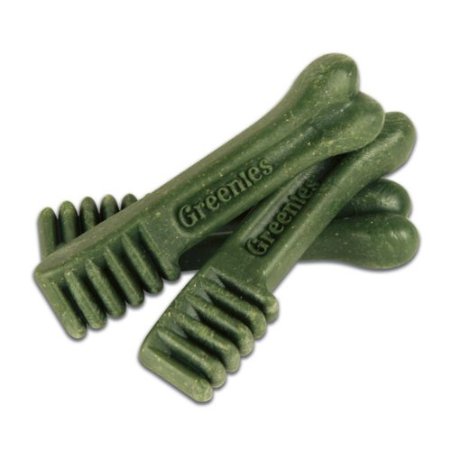
Online Veterinary 24/7
Chat With A Veterinarian OnlineConnect with a verified veterinarian in minutes. Licensed vets are available 24/7 to answer your questions. No need to worry about your furry family member.
Has your dog eaten too many Greenies? Are you worried the Greenies will make him sick? If so, then youve come to the right place.
In this article, well take a look at what Greenies are and whether or not they can make your dog sick. Lets get started!
What are Greenies?
Greenies are a dog dental chew, which is supposed to help keep dogs teeth healthy and improve bad breath. The treats are a green color and look a little bit like a toothbrush on one end. Greenies are supposed to remove plaque and tartar and keep a dogs teeth cleaner.
Greenies have been popular for years; however, there have been some cases where dogs swallowed one or more Greenies and developed a blockage. In some cases, the dogs died.
These treats are made of natural ingredients, which include:
- Wheat flour
- Glycerin
- Wheat gluten
- Gelatin
- Water
- Powdered cellulose
- Lecithin
- Minerals
- Turmeric color
These treats are nutritionally complete and are made with easily digestible ingredients. However, can Greenies make your dog sick? What happens if your dog has too many Greenies?
How Many Greenies Can a Dog Have?
According to the Greenies manufacturer, dogs should have one Greenies treat daily.
In addition, Greenies come in various sizes, so its easy to find Greenies that are just the right size for your fur baby. If you have a small dog, its essential to choose the smaller chews, as these are more difficult for your dog to swallow. For instance, petite Greenies are made for dogs between 17-25 lbs. Teenie Greenies are best for dogs that are between 6-15 lbs, while Regular Greenies are for dogs between 25-50 lbs, and Large Greenies are best for dogs between 50-100 lbs.
So, be sure to choose Greenies that are the right size for your fur baby, and this can lessen the chance of your dog swallowing the Greenies.
Chat With a Veterinarian For Personalized Help
Review symptoms, medications & behavior to keep your pets healthy with a Vet Online in just minutes.
Ask a Vet Live NowGreenies & Dogs
Too many Greenies can make your dog sick. Dogs may develop digestive issues, or if large pieces of the Greenies were swallowed, they could lead to an intestinal blockage. This is a painful condition that can lead to death if not treated urgently by your vet.
Symptoms of a Dog Ingesting Too Many Greenies
You may notice these symptoms if your dog has eaten too many Greenies:
- Nausea
- Vomiting
- Empty retching
- Abdominal pain & swelling
- Excessive panting
- Lethargy
- Reduced appetite
- Diarrhea
- Constipation/lack of feces
If you notice any of these symptoms in your dog, its time to call the vet. This could be a medical emergency.
One note: Do not induce vomiting. If the vet recommends this, they will induce vomiting in the veterinary clinic.
Stay calm.If possible, try to figure out how many Greenies your dog has eaten and try to determine if they chewed them up or ate them in large chunks. It can also help to bring the packaging along when you visit the vet.
Is your dog showing any symptoms (such as those mentioned above)? Your vet will want to know what symptoms your fur babys showing. These are necessary for making the right diagnosis.
Treatment of an Intestinal Blockage in Dogs
At the vets, they will first perform a complete physical exam on your dog. They may then decide to further investigate your dogs illness. This may include lab work, x-rays and an ultrasound. The x-rays and ultrasound will help the vet see if theres a blockage and where its located in the dogs digestive tract.
If the images show a blockage, then your canine companion will need emergency abdominal surgery to safely remove it. Your vet will discuss this in detail with you if your dog needs surgery.
The good news is that in most cases, dogs who receive prompt medical treatment will go on to make a full recovery. Your fur baby will be back to normal in a couple of weeks!
How to Keep Greenies Out of Your Dogs Reach
Its best to store Greenies and all of your dogs treats in a location he cant access. The goal is to keep your fur baby from helping himself to his treats and overdoing it!
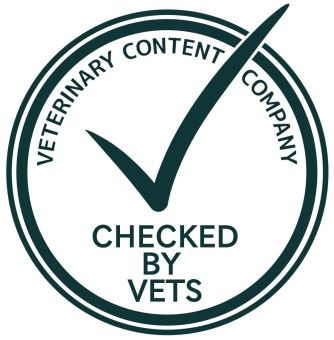
(Visited 16,815 times, 1 visits today)
Online Veterinary 24/7
Chat With A Veterinarian OnlineConnect with a verified veterinarian in minutes. Licensed vets are available 24/7 to answer your questions. No need to worry about your furry family member.
Aisling O'Keeffe, MVB CertSAM ISFMCertAdvFB
This article has been reviewed and approved by an independent Veterinarian: Aisling qualified as a vet 7 years ago from University College Dublin. She has worked in a mixture of UK small animal hospitals along with Irish practices. She worked for 3 years in a feline-only hospital where she further developed her feline medicine and surgery skills. She currently lives and works in a small animal hospital in Cork, Ireland.Chat With a Veterinarian For Personalized Help
Review symptoms, medications & behavior to keep your pets healthy with a Vet Online in just minutes.
Ask a Vet Live Now
